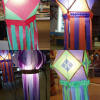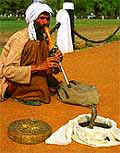| ||||||||
| ||||||||
The Maharashtrians are a vibrant, vivacious people for whom life itself is a celebration. All festivals in Maharashtra are celebrated with abundant fervour and enthusiasm. The Festivals are a true reflection of Maharashtrian culture, with all its colourful customs, rituals and traditions. The song, music and dance that accompany almost every festive occasion add joy and excitement to the lives of the people from every walk of life. The festivals are a tribute to Maharashtra's rich culture and legacy. The Maharashtrian calendar is dotted with festivals all round the year. The love for celebration is deeply embedded in their culture and it finds expression through the various occasions. |
Diwali Diwali or Deepawali means a row of lights. The most beautiful of all Indian festivals, Diwali is a celebration of li  ghts. Streets are illuminated with rows of clay lamps and homes are decorated with ghts. Streets are illuminated with rows of clay lamps and homes are decorated with rangoli (coloured powder designs) and aakash kandils (decorative lanterns of different shapes and sizes). People rise at dawn, massage their bodies and hair with scented oil and aromatic powders-uttana and take a holy bath. Diwali is celebrated with new clothes, spectacular firecrackers and a variety of sweets in the company of family and friends. rangoli (coloured powder designs) and aakash kandils (decorative lanterns of different shapes and sizes). People rise at dawn, massage their bodies and hair with scented oil and aromatic powders-uttana and take a holy bath. Diwali is celebrated with new clothes, spectacular firecrackers and a variety of sweets in the company of family and friends.
|
 | Nag Panchami It is a festival in the honour of the Snake God Shesha Nag . Snake worship is an important ritual of the Maharashtrians, and on the festival of Nag Panchami, clay icons of cobras are venerated in homes. People offer sweets and milk to the snake deity . Snake charmers carry cobras in baskets and collect offerings from the public in the streets. Women apply mehendi on their hands and the day is celebrated with dances and songs. |
Gudhi Padwa Gudhi' – is a victory symbol-characterized by a bamboo stick with a coloured silk cloth and garlanded with flowers and sweets atop . Maharashtrians erect gudhis on Padwa, the first day of the Hindu new year. People welcome the new year by worshipping the gudhi and distribute prasad comprising tender neem leaves, gram-pulse and jaggery. Gudhi Padwa signifies the beginning of a prosperous new year and is considered as a shubh muhurat - one of the most auspicious days - by Hindus. |
Pola The harvest festival is celebrated by farmers all over Maharashtra. It is an important festival of rural Maharashtra. On this day bullocks, which are an integral part of the agricultural operations are worshipped. They are bathed, colourfully decorated and taken out in processions across the village, accompanied by the music of drumbeats and lezhim (a musical instrument made of a wooden rod and an iron chain full of metallic pieces). |
Narali Pournima The full moon day of the month of Shravan is celebrated in different parts of Maharashtra and is known variously as Narali Pournima, Shravani Pournima, Rakhi Pournima or Raksha Bandhan. 'Naral' means 'coconut', and Narali Pournmia is thus called because offerings of coconuts are made by people to the sea-god on this day. Narali Pournima also marks the advent of the new fishing season and fishermen appease the sea-god before sailing out in their gaily-decorated boats. The festival is a day of singing and dancing. Raksha Bandhan is also observed on this day. Sisters tie 'rakhis' or beautifully decorated threads on their brothers' wrists. The ritual renews the bond of affection between siblings and signifies the brother's responsibility of protecting his sister all her life. |
 | Ganesh Chaturthi Lord Ganesh, the patron deity of Maharashtra, is the God of wisdom. In August, preparations to celebrate Ganesh Chaturthi - the auspicious day when Lord Ganesh was born - begin with great enthusiasm all over the state. The 11-day festival begins with the installation of beautifully sculpted Ganesh idols in homes and mandaps (large tents), colourfully decorated, depicting religious themes or current events. The Ganesh idols are worshipped with families and friends. Many cultural events are organised and people participate in them with keen interest. After ten exciting days comes the time to bid farewell to the beloved God. People take Ganesh idols in procession to the accompaniment of music and dance for immersion in the sea or nearby river or lake. |
Dussehra According to the great Hindu epic Ramayan, Dussehra is the day on which Lord Ram killed Ravan, the evil king of Lanka. It is considered as a shubh-muharat - a very auspicious day - to start a new venture. It is a symbol of the victory of good over evil. People decorate the entrances of their homes with torans, marigold flower studded strings, and worship the tools of trade, vehicles, machinery, weapons and books. As the evening falls, the villagers cross the border, a ritual known as Simollanghan, and worship the Shami tree. The leaves of the Apta tree are collected and exchanged among friends and relatives as gold. |
Holi/Vasant Panchami Holi/Vasant Panchami each year, after a successful winter harvest, people get ready to welcome the spring with Holi - the festival of colours. Holi or bonfires are lit in the night and to worship the fire-god, who is believed to drive away all evil. On the next day, people of all ages come outside and play with each other with coloured water. Brightly coloured powders are applied on faces, and there is plenty of music, dance and sweets to fill the rest of the day. |
Modern Festivals of Maharashtra |
The Banganga Festival Every year, in January, a cultural extravaganza is organised at Banganga, where top artistes from around the country perform live classical music concerts. Cultural enthusiasts attend the festival and feast the soul as well as the mind as the sun sets |
The Elephant Festival In February Elephanta, a small island near Mumbai, is a favoured destination for culture lovers. It is the site of the Elephanta Festival, the tranquil abode of Lord Shiva, just one-and-a-half-hour's journey by motor launch from Mumbai. Every year, renowned dancers and musicians perform outside the caves, beneath a star-studded sky, to a select and appreciative audience. Special launch services and catering arrangements are provided for visitors. |  |
The Ellora Festival MTDC organises the Ellora Festival here in December, inviting in renowned artistes who display their virtuosity in music and dance. Surrounded by 1,400-year old caves and rock carvings, artists perform in this magnificent ambience to enchant the gods, goddesses and human lovers of art. The Kailash temple, sculptured out of one huge rock, is one of the most beautiful backdrops for an event such as this. |



Excellent read, positive site, where did you come up with the information on this posting ? I have read a few of the articles on your website now and I really like your style. Thanks a million and please keep the effective work.
ReplyDeleteEach and everything about Pune